英汉语言对比-习题_+答案汇编
新英汉翻译教程 第三章.英汉语言对比答案

小节结束
16 返回章重点 退出
3. 1. 3 英语爱用静态词,汉语常用动态词
英语喜欢使用静态词汇,而汉语则 多使用动态词汇,英译汉时常常把原文 中表示动作意义的静态叙述转换成汉语 的动态叙述。
第 三 章 重 点
3. 2 英汉词汇表达对比
3.2.1 英语词汇含义多 3.2.2 英语词汇搭配多 3.2.3 英语词汇在句中的位置多
课堂互动2
3. 3 英汉句法结构对比
3.3.1 英汉句子结构的互换 A. 英语简单句可转换成汉语复合句 B. 英语并列句、复合句可转换成汉语简单句 3.3.2 英汉句子顺序的调整 A.调整时间顺序 B.调整空间顺序 课堂互动3 C.调整逻辑顺序
17 返回章重点 退出
例1:Inspiration is the number one cause of greatness. If information is power, then inspiration must be the power of our potential. The power that moves us from the systematic to the spontaneous. From ideas to results.
【译文】这时候,他从烤架上拿了些羊肉,庄重地送 到我们面前,我们各自取了一些,可是我们早已 没有了胃口,只不过做做样子,装吃罢了。
15 返回章重点 退出
例2:Harvard Business School opened in the early 20th century, and pioneered the casestudy method of teaching—making use of real-world scenarios, instead of relying on academic theory—a methodology that has remained the bases for many MBA programmes around the world today.
英汉语言对比考试复习资料
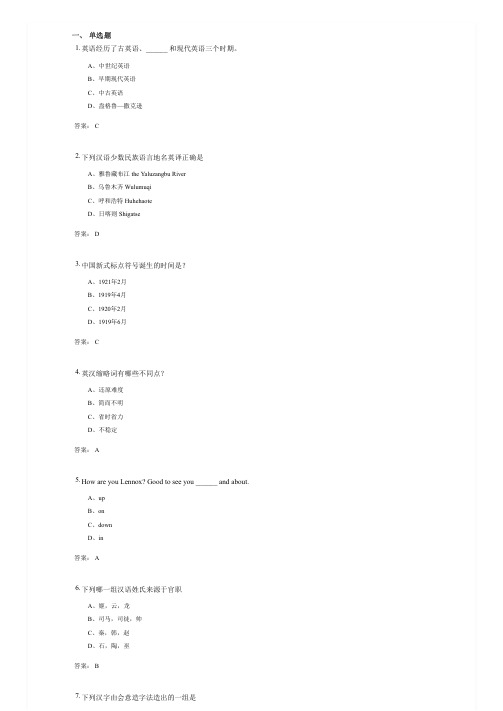
一、单选题1.英语经历了古英语、______ 和现代英语三个时期。
A、中世纪英语B、早期现代英语C、中古英语D、盎格鲁—撒克逊答案: C2.下列汉语少数民族语言地名英译正确是A、雅鲁藏布江 the Yaluzangbu RiverB、乌鲁木齐 WulumuqiC、呼和浩特 HuhehaoteD、日喀则 Shigatse答案: D3.中国新式标点符号诞生的时间是?A、1921年2月B、1919年4月C、1920年2月D、1919年6月答案: C4.英汉缩略词有哪些不同点?A、还原难度B、简而不明C、省时省力D、不稳定答案: A5.How are you Lennox? Good to see you ______ and about.A、upB、onC、downD、in答案: A6.下列哪一组汉语姓氏来源于官职A、姬,云,龙B、司马,司徒,帅C、秦,韩,赵D、石,陶,巫答案: B7.下列汉字由会意造字法造出的一组是A、明武信林B、拉河山森C、忘想小大D、武木林足答案: A8.“pull one's leg”的译文是______?A、扯后腿B、开玩笑C、赶紧,快点D、阻止某人答案: B二、判断题1.综合语的特征是运用词的形态变化来表达语法关系。
A、正确B、错误答案:正确2.分析语的特征是用语序及虚词来表达语法关系。
A、正确B、错误答案:正确3.“我家的后面有一个很大的园,相传叫作百草园。
”该句最符合英语表达习惯的译文是Behind our house was a great garden commonly known as Hundred-plant Garden.A、正确B、错误答案:正确4.汉语句子流散的原因:缺乏形态变化、固定语序、主题突出特点、主语跳跃A、正确B、错误答案:正确5.She is such a trouble-maker that no one likes to be in the same team with her.该句最符合汉语表达习惯的译文是她是个会制造麻烦的人,没人愿意跟她呆在一组。
英汉语言对比-练习题-2-reference answers
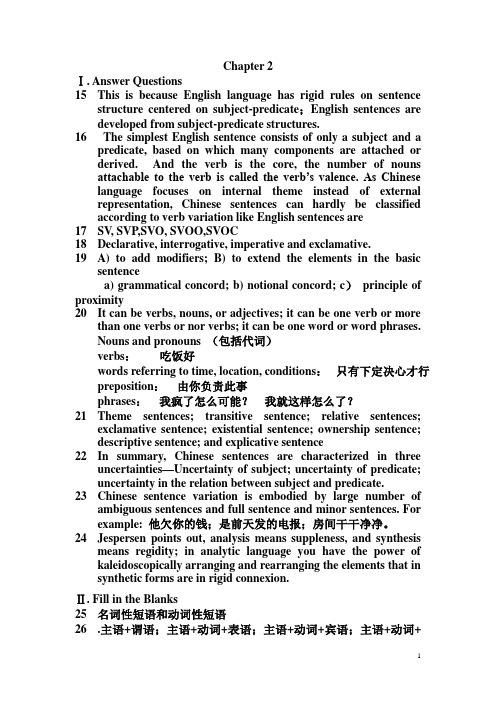
Chapter 2Ⅰ. Answer Questions15This is because English language has rigid rules on sentence structure centered on subject-predicate;English sentences are developed from subject-predicate structures.16The simplest English sentence consists of only a subject and a predicate, based on which many components are attached or derived. And the verb is the core, the number of nouns attachable to the verb is called the verb’s valence. As Chinese language focuses on internal theme instead of external representation, Chinese sentences can hardly be classified according to verb variation like English sentences are17SV, SVP,SVO, SVOO,SVOC18Declarative, interrogative, imperative and exclamative.19A) to add modifiers; B) to extend the elements in the basic sentencea) grammatical concord; b) notional concord; c)principle of proximity20It can be verbs, nouns, or adjectives; it can be one verb or more than one verbs or nor verbs; it can be one word or word phrases.Nouns and pronouns (包括代词)verbs:吃饭好words referring to time, location, conditions:只有下定决心才行preposition:由你负责此事phrases:我疯了怎么可能?我就这样怎么了?21Theme sentences; transitive sentence; relative sentences;exclamative sentence; existential sentence; ownership sentence;descriptive sentence; and explicative sentence22In summary, Chinese sentences are characterized in three uncertainties—Uncertainty of subject; uncertainty of predicate;uncertainty in the relation between subject and predicate.23Chinese sentence variation is embodied by large number of ambiguous sentences and full sentence and minor sentences. For example: 他欠你的钱;是前天发的电报;房间干干净净。
英汉对比单元测试题及答案

英汉对比单元测试题及答案一、选择题(每题2分,共20分)1. 在英语中,“book”一词的意思是:A. 书B. 笔C. 桌子D. 椅子答案:A2. 英语中的“happy”和汉语中的“快乐”在意义上:A. 完全不同B. 部分相似C. 完全相同D. 部分相反答案:C3. 汉语中的“苹果”在英语中对应的词是:A. appleB. orangeC. bananaD. grape答案:A4. 英语中的“she”指的是:A. 他B. 她C. 它D. 他们答案:B5. 以下哪个词组在英语和汉语中意义相同?A. 看医生B. 看门狗C. 看电影D. 看风景答案:C二、填空题(每空1分,共10分)6. 英语中的“family”在汉语中通常翻译为_。
答案:家庭7. 汉语中的“学习”在英语中可以翻译为_。
答案:study 或 learn8. 英语中的“thank you”在汉语中通常翻译为_。
答案:谢谢9. 汉语中的“老师”在英语中对应的词是_。
答案:teacher10. 英语中的“good morning”在汉语中翻译为_。
答案:早上好三、翻译题(每题5分,共30分)11. 将下列英语句子翻译成汉语:- "What's your name?"答案:你叫什么名字?12. 将下列汉语句子翻译成英语:- 我喜欢吃苹果。
答案:I like eating apples.13. 将下列英语句子翻译成汉语:- "Where are you going?"答案:你要去哪里?14. 将下列汉语句子翻译成英语:- 她是一名医生。
答案:She is a doctor.四、简答题(每题5分,共20分)15. 英语和汉语在语法结构上有哪些主要差异?答案:英语和汉语在语法结构上的主要差异包括:英语使用主谓宾结构,而汉语则更倾向于主谓宾或主宾谓;英语中动词时态和语态的变化较为复杂,汉语则通过时间词和上下文来表达;英语中有明确的冠词使用规则,而汉语中则没有冠词。
英汉语言对比_华中科技大学中国大学mooc课后章节答案期末考试题库2023年
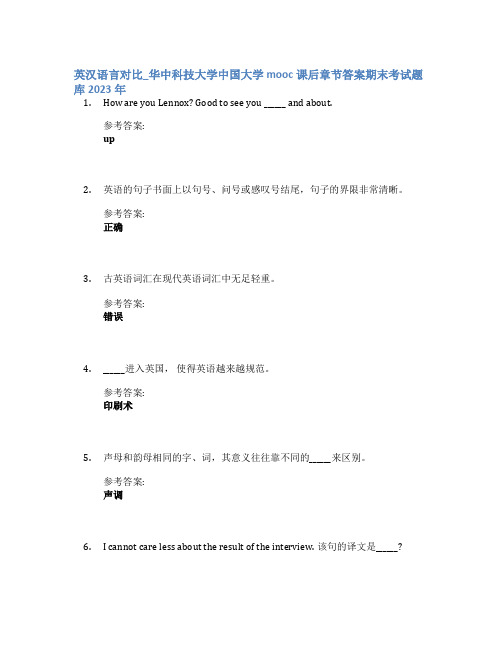
英汉语言对比_华中科技大学中国大学mooc课后章节答案期末考试题库2023年1.How are you Lennox? Good to see you ______ and about.参考答案:up2.英语的句子书面上以句号、问号或感叹号结尾,句子的界限非常清晰。
参考答案:正确3.古英语词汇在现代英语词汇中无足轻重。
参考答案:错误4.______进入英国,使得英语越来越规范。
参考答案:印刷术5.声母和韵母相同的字、词,其意义往往靠不同的______来区别。
参考答案:声调6.I cannot care less about the result of the interview. 该句的译文是______?参考答案:我一点也不在乎这次面试的结果。
7.汉语的被动式所表达的一般是不如意或不企望的事情参考答案:正确8.I'd do it with pleasure, only that I am too busy. 该句的译文是______?参考答案:我很高兴去做这件事,只是我太忙了做不了。
9.隐喻类似于传统意义上修辞学中的暗喻,指人们用一个具体的概念来理解另一个抽象概念的方式。
参考答案:正确10.英语的结构被动句要比汉语结构被动使用频率高得多。
参考答案:正确11.汉语中的婚姻表达比英语中包含更多的容器隐喻。
参考答案:正确12.“他最近情绪很低落。
"该句的译文是 He's been so ______ lately.参考答案:down13.“望子成龙”的译文是“to hope one's children will ______”。
参考答案:have a bright future14.“pull one's leg”的译文是______?参考答案:开玩笑15.“喜结连理,百年好合。
”该句中包含的婚姻隐喻是______?参考答案:婚姻是连接16.连动结构中所有动词与同一主语构成主谓关系。
英汉语言对比练习答案2

1.翻译下列句子,注意调整语序1)A reader’s perception of the loose, slangy, colloquial, shirt-sleeved quality of much modern prose will be sharpened if he has experienced the conscious elegance of eighteenth-century writers and the solemn lecture-hall pronouncements of the Victorians. (按照逻辑顺序译)【译文】如果一位读者读过18世纪作家的作品,体会到其刻意追求典雅的语言风格,又读过维多利亚女王时代的人在演讲大厅上所作的庄严的发言,他定能更深刻地理解很多现代散文作品那种结构松散、口语色彩浓、好用俚语、不拘形式的语言风格。
2)He felt a qualm in his stomach, and it was more in memory of his own loneliness than anticipation of hers.(按照信息中心译)【译文】他感到一阵心酸,与其说是预见了她的凄凉,倒不如说是想到了他自己的孤独。
3)Based on national realities and taking reasonable aspects of foreign economies, Chinese economists are working to establish socialist market economy, which ensures economic activities follow the requirements of the law of value and the changing relationship between supply and demand. (按照搭配需要译)【译文】在立足本国实际和借鉴海外经济合理成分的基础上,中国经济学者正致力于建立社会主义市场经济,要保证经济活动遵循价值规律的要求,适应供求关系的变化。
最新英汉语言对比-习题·+答案
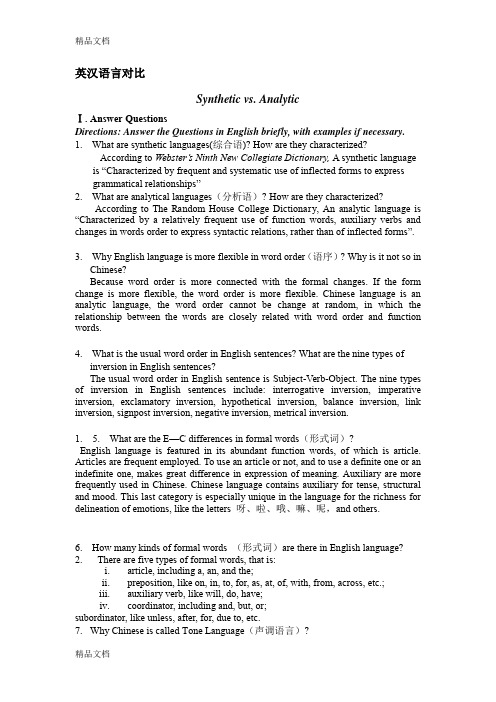
英汉语言对比Synthetic vs. AnalyticⅠ. Answer QuestionsDirections: Answer the Questions in English briefly, with examples if necessary. 1.What are synthetic languages(综合语)? How are they characterized?According to Webster’s Ninth New Collegiate Dictionary, A synthetic language is “Characterized by frequent and systematic use of inflected forms to express grammatical relationships”2.What are analytical languages(分析语)? How are they characterized?According to The Random House College Dictionary, An analytic language is “Characterized by a relatively frequent use of function words, auxiliary verbs and changes in words order to express syntactic relations, rather than of inflected forms”.3.Why English language is more flexible in word order(语序)? Why is it not so inChinese?Because word order is more connected with the formal changes. If the form change is more flexible, the word order is more flexible. Chinese language is an analytic language, the word order cannot be change at random, in which the relationship between the words are closely related with word order and function words.4.What is the usual word order in English sentences? What are the nine types ofinversion in English sentences?The usual word order in English sentence is Subject-Verb-Object. The nine types of inversion in English sentences include: interrogative inversion, imperative inversion, exclamatory inversion, hypothetical inversion, balance inversion, link inversion, signpost inversion, negative inversion, metrical inversion.1. 5.What are the E—C differences in formal words(形式词)?English language is featured in its abundant function words, of which is article. Articles are frequent employed. To use an article or not, and to use a definite one or an indefinite one, makes great difference in expression of meaning. Auxiliary are more frequently used in Chinese. Chinese language contains auxiliary for tense, structural and mood. This last category is especially unique in the language for the richness for delineation of emotions, like the letters 呀、啦、哦、嘛、呢,and others.6.How many kinds of formal words (形式词)are there in English language?2.There are five types of formal words, that is:i.article, including a, an, and the;ii.preposition, like on, in, to, for, as, at, of, with, from, across, etc.;iii.auxiliary verb, like will, do, have;iv.coordinator, including and, but, or;subordinator, like unless, after, for, due to, etc.7.Why Chinese is called Tone Language(声调语言)?Chinese tone can be used for indicating the change of meaning and is not suitable for expressing the certainty, completeness, independence or finality.Ⅱ. Fill in the BlanksDirections: Fill in the blanks with the best answer you have found in the textbook.1.11.综合语的特征是经常性、系统性的运用曲折形式来表现语法关系为特征的语言,分析语的特征是分析语的特征是相对频繁地使用功能词,助词和改变词序来表达句法关系,而不用曲折形式来表达。
英汉对比研究试题答案
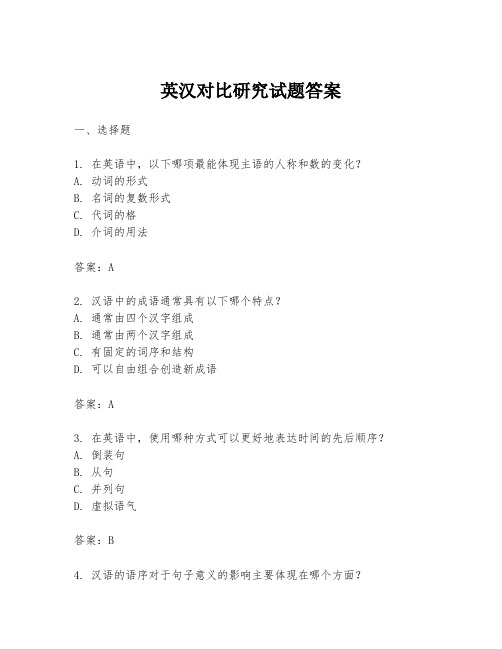
英汉对比研究试题答案一、选择题1. 在英语中,以下哪项最能体现主语的人称和数的变化?A. 动词的形式B. 名词的复数形式C. 代词的格D. 介词的用法答案:A2. 汉语中的成语通常具有以下哪个特点?A. 通常由四个汉字组成B. 通常由两个汉字组成C. 有固定的词序和结构D. 可以自由组合创造新成语答案:A3. 在英语中,使用哪种方式可以更好地表达时间的先后顺序?A. 倒装句B. 从句C. 并列句D. 虚拟语气答案:B4. 汉语的语序对于句子意义的影响主要体现在哪个方面?A. 主谓一致B. 修饰语的位置C. 动词的时态D. 名词的数答案:B5. 英语中的动词时态主要用来表达什么?A. 说话者的情绪B. 动作发生的时间和状态C. 句子的连贯性D. 语气的强度答案:B二、填空题1. 在英语中,第三人称单数的现在时动词通常需要在词尾加上________。
答案:-s2. 汉语中的量词用于表示事物的数量,而在英语中,通常使用________来表示类似的功能。
答案:冠词3. 英语中的虚拟语气多用于表达非现实情况,如假设、建议等,而在汉语中,通常使用________来表达类似的语气。
答案:情态动词4. 汉语中的成语往往具有深厚的文化内涵和历史背景,而在英语中,相应的表达方式可能是________。
答案:习语或idiom5. 英语中的名词有可数和不可数之分,而在汉语中,名词通常可以通过________来表示数量。
答案:量词三、简答题1. 请简述英语中的被动语态及其用法。
答:被动语态是英语中的一种语态,用来强调动作的承受者而非执行者。
它通过使用“be”动词的适当形式加上主动语态动词的过去分词来构成。
被动语态常用于当动作的执行者未知、不重要或希望突出动作承受者时。
2. 汉语中的“把”字句和“被”字句有什么区别?答:“把”字句和“被”字句都是汉语中用来表示动作和受事的结构。
不同之处在于,“把”字句强调动作的完成和受事的改变,通常用于有具体结果的情境;而“被”字句则强调受事的被动状态,不一定要求动作完成,更多地用于表达受事的遭遇或经历。
英汉语言对比_华中科技大学中国大学mooc课后章节答案期末考试题库2023年
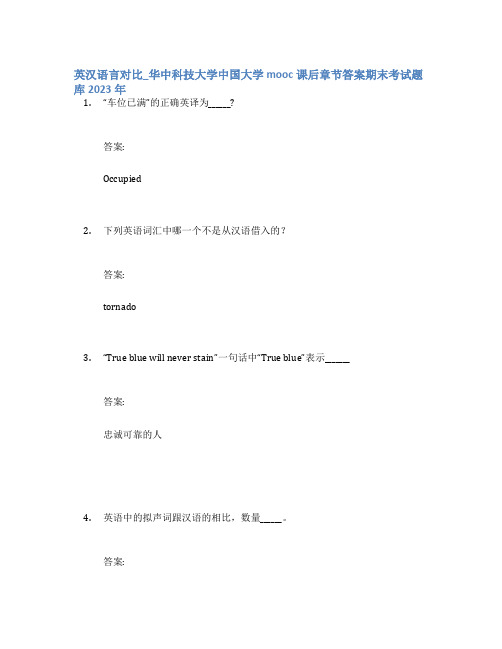
英汉语言对比_华中科技大学中国大学mooc课后章节答案期末考试题库2023年1.“车位已满”的正确英译为______?答案:Occupied2.下列英语词汇中哪一个不是从汉语借入的?答案:tornado3.“True blue will never stain”一句话中“True blue”表示_______答案:忠诚可靠的人4.英语中的拟声词跟汉语的相比,数量______。
答案:更多5.下列哪一个植物词语在英语中象征春天?答案:daisy6.英语姓氏中的前缀O'代表什么含义?答案:某人的后裔7.哪一个选项不是汉语姓氏的来源?答案:体型8."Long time no see."属于哪种借词方式?洋泾浜英语9.下列选项中哪一个词表示“卑劣、胆怯的人”?答案:yellow dog10.“bird dog”一词的意思为_______。
答案:寻找新人才的人、猎头11.“white feather”一词的比喻意义是_______。
答案:胆小12.汉语的大多数的抑扬顿挫是通过_______来实现的。
声调13.“我喜欢徒步,他也喜欢徒步”的正确译文是:_______?答案:I like hiking, so does he.14.We are told that he will come tonight, and if so, our meeting will be heldtomorrow.该句中的替代形式是_______?答案:分句性替代15.英语为______语言,因此需要______重复.答案:形合;避免16.Apple has just luanched its new iPhone and this gadget can be chargedwirelessly. 该句使用的是______变换手法。
答案:上下义词17.To err is human; to forgive, divine.该句中的省略形式是_______?答案:动词省略18.“blue book”的意思是_______。
翻译理论英汉对比版 附带习题和部分答案(适合考试准备)

复习提纲:What is translation and its essence?(什么是翻译和其本质?)Translation is the expression in one language of what has been expressed in another language, preserving semantic and stylistic equivalence. It is a kind of cross-language, cross-culture and cross society language activity. Its essence is the meaning explanation and transformation翻译是用一种语言把另一种语言所表达的思维内容准确完整地重新表达出来的,跨语言,跨交际,跨社会的语言活动。
其本质是释意,意义的转换。
types of translation(翻译的分类)From the stand point of signs: intralingual translation,interlingual translation and intersemiotic translation从涉及的符号来看:语内翻译,语际翻译,符际翻译From the stand point of the extent to which translation is done:full translation,partial translation and translation plus editing从翻译的方法来看:全译,摘译,编译From the stand point of way in translation is carried out:written interlingual translation,oral interlingual translation and machine translation从翻译的手段来看:笔译,口译,机器翻译From the stand point of the languages involved:native language into foreign language and foreign language into native language从source language and target language的角度:本族语译外族语,外族语译本族语From the stand point of the subject matter:professional translation(juristic and science writings),literary translation(novel,poem and drama)and general translation从翻译的题材来看:专业翻译(法律,科技文献),文学翻译(诗歌,散文,戏剧),一般性翻译(各种应用文和新闻报道)procedure of translation(翻译的过程)accurate comprehension,adequate expression and testing(理解,表达,校核)comprehension contains grammatical analysis,semantic analysis,stylistic analysis and discourse analysis理解分为:语法分析,意义分析,风格分析和语篇分析adequate expression:literal translation,translation by ideas and both of them表达分为直译,意译和两者并用criteria of translation(翻译的标准)Alexander F. Tytler(亚历山大F. 泰特勒)(1)A translation should give a complete transcript of the ideas of the original work(译作应完全复写出原作的思想)(2)The style and manner of writing should be of the same character as that of the original(译作的风格和手法应和原作属于同一性质)(3)A translation should have all the ease of the original composition.(译作应具备原作具有的通顺)Popular western criteria:equivalent value,equivalent effect and equivalent function(西方流行标准:等值,等效,功能对等)similarity in function and correspondence in meaning(功能相似,语义相符)Fedorov(费德罗夫)The exactness of translation means the exact rendering of the thought and content of the original and performs the same rhetorical function as the original. (翻译等值理论)Eugene Nida (尤金奈达)functional equivalence(功能对等)The crucial problem of translation is often stated in terms of conflict between formal correspondence and functional equivalence.Yan Fu(严复)faithfulness, expressiveness and elegance(信达雅)译事三难,信,达,雅,求其信已大难矣,顾信矣不达,虽译犹不译也,则尚达焉。
英汉对比考试题及答案高中

英汉对比考试题及答案高中一、选择题1. 在英语中,"apple"一词的中文意思是:A. 香蕉B. 苹果C. 橘子D. 梨答案:B2. 在汉语中,“老师”一词在英语中通常翻译为:A. StudentB. TeacherC. DoctorD. Nurse答案:B3. 英语中的“Hello”在汉语中通常翻译为:A. 再见B. 你好C. 晚安D. 早上好答案:B4. 下列哪个词组在英语和汉语中意思相同?A. 吃一堑,长一智B. 一石二鸟C. 一箭双雕D. 一言难尽答案:C5. 英语中的“Homework”在汉语中通常指的是:A. 家庭作业B. 家务C. 家访D. 家庭答案:A二、填空题6. 英语中的“family”一词在汉语中可以翻译为“_______”。
答案:家庭7. 在汉语中,“学习”一词在英语中可以翻译为“_______”。
答案:study 或 learn8. 英语中的“Thank you”在汉语中通常翻译为“_______”。
答案:谢谢9. 汉语中的“朋友”在英语中可以翻译为“_______”。
答案:friend 或 friends10. 英语中的“Good morning”在汉语中通常翻译为“_______”。
答案:早上好三、翻译题11. 请将下列英语句子翻译成汉语:- "What's your name?"- "Where are you from?"- "How are you doing?"答案:- 你叫什么名字?- 你来自哪里?- 你最近怎么样?12. 请将下列汉语句子翻译成英语:- 你今天过得怎么样?- 我很高兴见到你。
- 明天见。
答案:- How was your day?- I'm very happy to meet you.- See you tomorrow.四、简答题13. 请简述英语和汉语在语法结构上的主要差异。
英汉对比试题及答案

英汉对比试题及答案一、选择题1. 下列哪个选项是英语中“书”的对应词?A. ChairB. BookC. DeskD. Pen答案:B2. 在汉语中,“红色”对应的英语单词是什么?A. BlueB. RedC. GreenD. Yellow答案:B3. 英语中表示“学习”的动词是什么?A. PlayB. LearnC. WorkD. Rest答案:B4. “老师”在英语中怎么说?A. TeacherB. StudentC. DoctorD. Nurse答案:A5. 下列哪个短语在英语中表示“在周末”?A. At weekendB. On weekendC. In weekendD. During the weekend答案:D二、填空题6. 英语中“早上好”是 _______。
答案:Good morning7. “谢谢你的帮助”在英语中可以表达为 _______。
答案:Thank you for your help8. “我来自中国”用英语怎么说?答案:I come from China / I am from China9. “他喜欢游泳”在英语中的正确表达是 _______。
答案:He likes swimming10. “明天见”的英文表达是 _______。
答案:See you tomorrow三、翻译题11. 将下列汉语句子翻译成英语。
“他每天骑自行车上班。
”答案:He rides his bike to work every day.12. 将下列英语句子翻译成汉语。
“She is a teacher at the university.”答案:她是大学里的一位老师。
13. 翻译下列英语短语。
“Take care of yourself.”答案:照顾好自己。
14. 将下列汉语句子翻译成英语。
“这个周末我们打算去爬山。
”答案:We plan to go hiking this weekend.15. 翻译下列英语句子。
英汉语言对比-练习题-6-7-8-9-10-reference answers
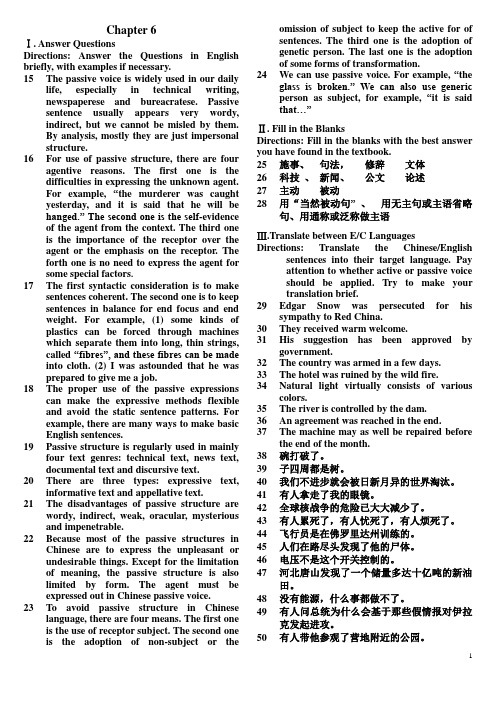
Chapter 6Ⅰ. Answer QuestionsDirections: Answer the Questions in English briefly, with examples if necessary.15The passive voice is widely used in our daily life, especially in technical writing,newspaperese and bureacratese. Passivesentence usually appears very wordy,indirect, but we cannot be misled by them.By analysis, mostly they are just impersonalstructure.16For use of passive structure, there are four agentive reasons. The first one is thedifficulties in expressing the unknown agent.For example, “the murderer was caughtyesterday, and it is said that he will behanged.” The second one is the self-evidenceof the agent from the context. The third oneis the importance of the receptor over theagent or the emphasis on the receptor. Theforth one is no need to express the agent forsome special factors.17The first syntactic consideration is to make sentences coherent. The second one is to keepsentences in balance for end focus and endweight. For example, (1) some kinds ofplastics can be forced through machineswhich separate them into long, thin strings,called “fibres”, and these fibres can be madeinto cloth. (2) I was astounded that he wasprepared to give me a job.18The proper use of the passive expressions can make the expressive methods flexibleand avoid the static sentence patterns. Forexample, there are many ways to make basicEnglish sentences.19Passive structure is regularly used in mainly four text genres: technical text, news text,documental text and discursive text.20There are three types: expressive text, informative text and appellative text.21The disadvantages of passive structure are wordy, indirect, weak, oracular, mysteriousand impenetrable.22Because most of the passive structures in Chinese are to express the unpleasant orundesirable things. Except for the limitationof meaning, the passive structure is alsolimited by form. The agent must beexpressed out in Chinese passive voice.23To avoid passive structure in Chinese language, there are four means. The first oneis the use of receptor subject. The second oneis the adoption of non-subject or theomission of subject to keep the active for ofsentences. The third one is the adoption ofgenetic person. The last one is the adoptionof some forms of transformation.24We can use passive voice. For example, “the glass is broken.” We can also use genericperson as subject, for example, “it is saidthat…”Ⅱ. Fill in the BlanksDirections: Fill in the blanks with the best answer you have found in the textbook.25施事、句法,修辞文体26科技、新闻、公文论述27主动被动28用“当然被动句” 、用无主句或主语省略句、用通称或泛称做主语Ⅲ.Translate between E/C Languages Directions: Translate the Chinese/English sentences into their target language. Payattention to whether active or passive voiceshould be applied. Try to make yourtranslation brief.29Edgar Snow was persecuted for his sympathy to Red China.30They received warm welcome.31His suggestion has been approved by government.32The country was armed in a few days.33The hotel was ruined by the wild fire.34Natural light virtually consists of various colors.35The river is controlled by the dam.36An agreement was reached in the end.37The machine may as well be repaired before the end of the month.38碗打破了。
英汉语言对比(二)练习答案
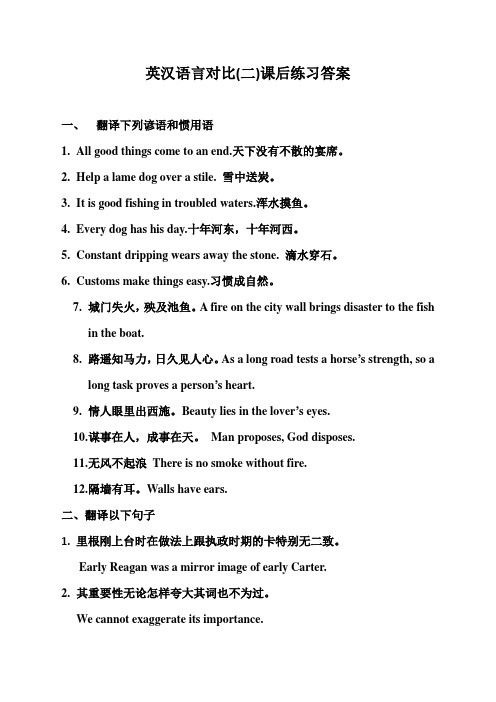
英汉语言对比(二)课后练习答案一、翻译下列谚语和惯用语1.All good things come to an end.天下没有不散的宴席。
2.Help a lame dog over a stile. 雪中送炭。
3.It is good fishing in troubled waters.浑水摸鱼。
4.Every dog has his day.十年河东,十年河西。
5.Constant dripping wears away the stone. 滴水穿石。
6.Customs make things easy.习惯成自然。
7.城门失火,殃及池鱼。
A fire on the city wall brings disaster to the fishin the boat.8.路遥知马力,日久见人心。
As a long road tests a horse’s strength, so along task proves a person’s heart.9.情人眼里出西施。
Beauty lies in the lover’s eyes.10.谋事在人,成事在天。
Man proposes, God disposes.11.无风不起浪There is no smoke without fire.12.隔墙有耳。
Walls have ears.二、翻译以下句子1.里根刚上台时在做法上跟执政时期的卡特别无二致。
Early Reagan was a mirror image of early Carter.2.其重要性无论怎样夸大其词也不为过。
We cannot exaggerate its importance.3.人的思想形成了语言,而语言又形成了人的思想。
Language is shaped by, and shapes human thought.4.人非圣贤,孰能无过;过而能改,善莫大焉。
To err is human and to mend is a supreme merit.5.明年我们不应再给农民打白条了。
英汉语言对比作业及答案

1. Not knowing her telephone number, I can not contact her immediately. 【译文】由于不知道她的电话号码,我无法立刻与她联系。
2. Ignorance is the mother of fear as well as of admiration.【译文】无知是恐惧的根源,也是敬佩的根源。
3. With all his achievements he remains modest and prudent.【译文】她虽有很多成就,但还是谦虚谨慎。
4. Everything considered, your essay seems better written.【译文】如果各方面都考虑到,你的论文似乎会写得更好些。
5. We maintain that no peace situation is permanent which does not take into account the legitimate wishes of the majority of the people of any country.【译文】我们认为,如果不尊重一个国家大多数人民的正当愿望,任何和平局面都不会是持久的。
6.。
A reader’s perception of the loose, slangy, colloquial, shirt-sleeved quality of much modern prose will be sharpened if he has experienced the conscious elegance of eighteenth-century writers and the solemn lecture-hall pronouncements of the Victorians. (按照逻辑顺序)【译文】如果一位读者读过18世纪作家的作品,体会到其刻意追求典雅的语言风格.又读过维多利亚女王时代的人在演讲大厅上所作的庄严的发言,他定能更深刻地理解很多现代散文作品那种结构松散、口语色彩浓、好用俚语、不拘形式的语言风格。
汉外语言对比试题及答案
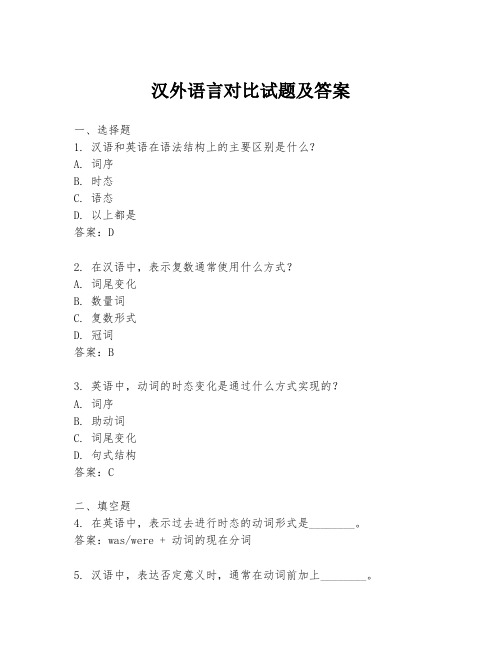
汉外语言对比试题及答案一、选择题1. 汉语和英语在语法结构上的主要区别是什么?A. 词序B. 时态C. 语态D. 以上都是答案:D2. 在汉语中,表示复数通常使用什么方式?A. 词尾变化B. 数量词C. 复数形式D. 冠词答案:B3. 英语中,动词的时态变化是通过什么方式实现的?A. 词序B. 助动词C. 词尾变化D. 句式结构答案:C二、填空题4. 在英语中,表示过去进行时态的动词形式是________。
答案:was/were + 动词的现在分词5. 汉语中,表达否定意义时,通常在动词前加上________。
答案:不6. 英语中,表示将来时态的动词形式是________。
答案:will + 动词原形三、简答题7. 请简述汉语和法语在语音方面的主要差异。
答案:汉语是一种声调语言,有四个声调,而法语没有声调。
汉语的音节结构相对简单,通常由一个音节组成一个词,而法语的音节结构较为复杂,一个词可能由多个音节组成。
8. 在英语中,如何使用情态动词表达可能性?答案:情态动词如can, could, may, might, will, would, shall, should等可以用来表达可能性。
例如,使用may表示可能性时,可以说:He may come to the party tonight.四、翻译题9. 请将以下汉语句子翻译成英语。
“他每天早晨都去公园散步。
”答案:He goes for a walk in the park every morning.10. 请将以下英语句子翻译成汉语。
"I don't think you should do that."答案:我认为你不应该那么做。
五、论述题11. 论述汉语和德语在词汇构成上的主要异同。
答案:汉语和德语在词汇构成上的主要异同体现在:汉语词汇多为单音节词,而德语词汇多为多音节复合词;汉语中存在大量同音异义词,而德语中同音异义词较少;汉语中词缀的使用较少,而德语中词缀的使用较为普遍,如动词的前缀和名词的后缀等。
英汉对比考试题库及答案

英汉对比考试题库及答案一、选择题1. 英语中,表示“和”的词是:A. AndB. OrC. ButD. So答案:A2. 汉语中,表示“但是”的词是:A. 但是B. 并且C. 然而D. 所以答案:A3. 在英语中,以下哪个词组表示“无论如何”?A. In any caseB. In any wayC. In any placeD. In any time答案:A4. 在汉语中,“无论如何”可以翻译为:A. 无论如何B. 无论如何都要C. 无论如何都不要D. 无论何时答案:A5. 英语中,表示“因为”的词是:A. BecauseB. SinceC. AlthoughD. If答案:A6. 汉语中,表示“因为”的词是:A. 因为B. 所以C. 尽管D. 然而答案:A二、填空题1. 英语句子 "I love you" 在汉语中可以翻译为 "________"。
答案:我爱你2. 汉语句子“他很聪明” 在英语中可以翻译为 "He is very________."。
答案:smart3. 英语中的 "Good morning" 在汉语中可以翻译为“________”。
答案:早上好4. 汉语中的“晚安” 在英语中可以翻译为 "________"。
答案:Good night三、翻译题1. 将下列英语句子翻译成汉语:- "I have a dream."答案:我有一个梦想。
2. 将下列汉语句子翻译成英语:- “她正在学习英语。
”答案:She is studying English.四、简答题1. 请简述英语和汉语在语法结构上的一个主要差异。
答案:英语和汉语在语法结构上的主要差异之一是英语强调词序和形态变化,而汉语则依赖于语序和语境来表达语法关系。
2. 请解释英语中的“虚拟语气”是什么,并给出一个例句。
汉英语言对比参考答案

汉英语言对比参考答案汉英语言作为世界上使用人数最多的两种语言,各自拥有独特的语言特点和丰富的文化内涵。
本文将从语音、词汇、语法、表达方式等方面对汉英语言进行对比分析,以期对两种语言的异同有一个全面的认识。
一、语音对比汉语属于汉藏语系,其语音系统以声母、韵母和声调为主。
汉语普通话有21个声母、39个韵母和4个声调,声调的变化可以改变词义。
例如,“妈”(mā)、“麻”(má)、“马”(mǎ)、“骂”(mà)。
英语属于印欧语系,其语音系统包括元音和辅音,没有声调的概念。
英语的发音更依赖于元音和辅音的组合,以及重音的分布。
例如,cat (猫)和bat(球棒)发音相似,但意义不同。
二、词汇对比汉语词汇以单音节词为主,每个音节都有意义,词汇的构成往往是通过词根和词缀的组合。
例如,“电”(diàn)可以与“视”(shì)组合成“电视”(diànshì),表示一种视觉媒介。
英语词汇则以多音节词为主,词汇的构成可以是词根、前缀、后缀的组合,也可以是复合词。
例如,“television”(电视)由“tele-”(远的)和“-vision”(视觉)组成,表示通过远距离传输的视觉媒介。
三、语法对比汉语的语法结构相对灵活,词序和虚词的使用是表达语法关系的主要手段。
例如,“我爱你”(Wǒ ài nǐ)和“你爱我”(Nǐ àiwǒ)通过改变词序来表达不同的主宾关系。
英语的语法结构则较为固定,依赖于词序和形态变化来表达语法关系。
例如,“He loves me”和“I love him”通过使用不同的助动词和宾格代词来表达主宾关系。
四、表达方式对比汉语表达往往含蓄,喜欢使用比喻、借代等修辞手法。
例如,“月有阴晴圆缺”(The moon has its phases of darkness and light)通过比喻表达人生的无常。
英语表达则相对直接,喜欢使用明喻和转喻等修辞手法。
- 1、下载文档前请自行甄别文档内容的完整性,平台不提供额外的编辑、内容补充、找答案等附加服务。
- 2、"仅部分预览"的文档,不可在线预览部分如存在完整性等问题,可反馈申请退款(可完整预览的文档不适用该条件!)。
- 3、如文档侵犯您的权益,请联系客服反馈,我们会尽快为您处理(人工客服工作时间:9:00-18:30)。
3. Why English language is more flexible in word orde(r 语序)? Why is it not so in Chinese? Because word order is more connected with the formal changes. If the form
4. What is the usual word order in English sentences? What are the nine types of
inversion in English sentences? The usual word order in English sentence is Subject-Verb-Object. The nine types of inversion in English sentences include: interrogative inversion, imperative inversion, exclamatory inversion, hypothetical inversion, balance inversion, link inversion, signpost inversion, negative inversion, metrical inversion.
6. How many kinds of formal words (形式词) are there in English language? 2. There are five types of formal words, that is:
i. article, including a, an, and the; ii. preposition, like on, in, to, for, as, at, of, with, from, across, etc.; iii. auxiliary verb, like will, do, have; iv. coordinator, including and, but, or; subordinator, like unless, after, for, due to, etc. 7. Why Chinese is called Tone Language(声调语言) ?
学习 ----- 好资料
英汉语言对比
Synthetic vs. Analytic
Ⅰ . Answer Questions
Directions: Answer the Questions in English briefly, with examples if necessary.
1. What are synthetic languages综( 合语 )? How are they characterized?
According to Dictionary, A synthetic language
is “ Characterized by frequent and systematic use of inflected forms to express
1. 5. What are the E—C differences in formal words(形式词) ? English language is featured in its abundant function words, of which is article.
Articles are frequent employed. To use an article or not, and to use a definite one or an indefinite one, makes great difference in expression of meaning. Auxiliary are more frequently used in Chinese. Chinese language contains auxiliary for tense, structural and mood. This last category is especially unique in the language for the richness for delineation of emotions, like the letters 呀、啦、哦、嘛、呢, and others.
change is more flexible, the word order is more flexible. Chinese language is an analytic language, the word order cannot be change at random, in which the relationship between the words are closely related with word order and function words.
grammatical relationships
”
2. What are analytical language(s 分析语) ? How are they characterized?
According to The Random House College Dictionary , An analytic language is “ Characterizedby a relatively frequent use of function words, auxiliary verbs and changes in words order to express syntactic relations, rather than of inflected forms
更多精品文档
学习 ----- 好资料
